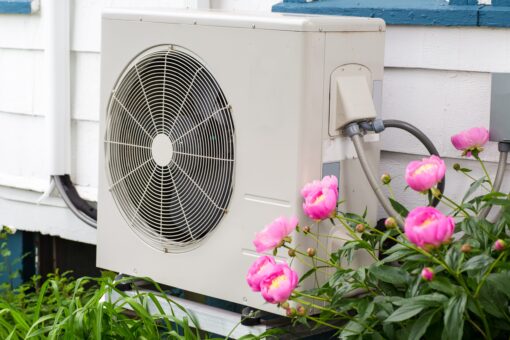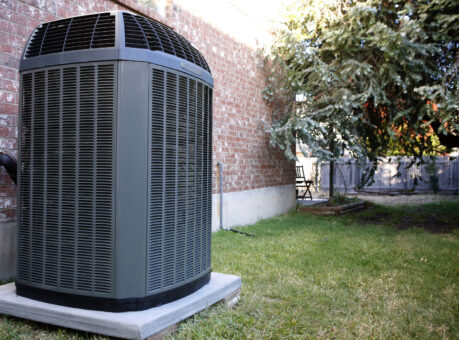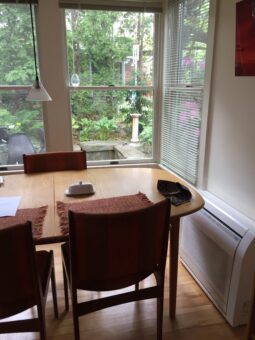Get your questions answered about heat pumps and the financial incentives available to you!
About air source heat pumps
Air source heat pumps (ASHP) are electric appliances that provide heating and cooling by moving heat into a home or building (for heating) or out of a building (for cooling). Heat pumps do not create heat like electric resistance heating or fossil fuel-fired heating systems; instead, they move heat from one place to another. ASHPs use the outdoor air as a source of heat, while ground source (or geothermal) heat pumps use the ground as a source of heat.They accomplish this by using a refrigerant that absorbs heat from the air to move that heat into another space – much the same way that a refrigerator or air conditioner works, except that it can move heat in both directions to provide both heating and cooling. Since it takes far less energy to move heat than it does to create heat, ASHPs are one of the most efficient home heating systems available.
There are two primary types of air source heat pumps (ASHPs):Ductless heat pumps are exactly as they sound: heat pumps that don’t require that you have ductwork in your home to provide heating and air conditioning. Each ductless system includes one outdoor unit connected to one (single-zone) or more (multi-zone) indoor wall, floor, or ceiling air distribution units. Ductless ASHPs are often referred to as ductless mini-splits.
Ductless air source heat pumps can be installed as a primary source of heating and cooling or installed to heat and cool specific areas of your building. This could include, for example, installing ductless units in the most frequently used rooms like family rooms or master bedrooms to displace heating or cooling from your existing system, or placing ductless units in rooms or new additions that never seem to be warm or cool enough.
These systems can be used for heating, cooling, and dehumidification. Because each indoor unit can be controlled individually, you can reduce your energy use even more by lowering the temperature in rooms that are not being used.
Ducted heat pumps have an outdoor unit that is connected to a building’s ductwork, which is used with an indoor air handling unit to distribute heating or air conditioning throughout the home. Ducted (also known as central or unitary) use your home’s existing ductwork, though not all ductwork is sized adequately for heat pumps. An installer can tell you if your ductwork is sized adequately and what modifications may be necessary during a free site visit.
Regardless of whether a system is ductless or ducted, all ASHPs will have an outdoor unit similar to that of a central air conditioner (pictured below), which will be mounted on a ground platform or on the side of your home.

Above: A ductless ASHP outdoor compressor unit.

Above: A ducted ASHP outdoor unit.

Above: The outdoor unit will be connected to one or more indoor air distribution units. If you’re installing a ducted ASHP, this will be a central air handler similar to one used by a furnace or central AC system. If you’re installing a ductless ASHP, this will typically be a wall-mounted unit (pictured above).

For homeowners that might not have suitable wall space or don’t like the aesthetic look of the wall-mounted indoor unit, floor-mounted (pictured above) units and ceiling cassettes (that look like vents in the ceiling) are also available, though these units cost more to install.
There are many reasons why an air source heat pump could be a good fit for your home:
- Improved home comfort. Advanced heat pumps are “variable capacity,” which means they can provide just the right amount of heating or cooling without temperature swings and constantly turning on and off. Also, they are much quieter than conventional air conditioners and furnaces.
- Energy savings. If you heat with oil, propane, or electric resistance (such as electric baseboards), you could save hundreds of dollars a year on your heating bill by installing an air source heat pump. If you heat with natural gas, you may not save on your heating bills now due to very low natural gas prices. However, natural gas prices could rise significantly in the future if carbon-based pricing is adopted.
- High-efficiency cooling, no ductwork required. Air source heat pumps also provide air conditioning and dehumidification and are more efficient than window units and most central air conditioning systems. Ductless ASHPs can allow you to reclaim your windows and avoid having to install window A/C units each summer.
- Improved health and air quality. In addition to providing cooling, heat pumps filter and dehumidify air, which can improve the air quality and comfort of your home. In particular, the filtration provided by advanced ASHP systems can significantly reduce allergens in your home for sensitive individuals.
- Flexible options. Heat pumps are a flexible technology that can be installed in homes of all shapes and sizes with different needs—whether you need a whole-home system replacement, have (or don’t have) ductwork, want to add zoning to your home, want to increase the efficiency of heating part of your home, or want to add extra heating/cooling to that part of your home that’s never as comfortable as it should be.
- Lower your carbon footprint. As a clean heating and cooling technology, converting from burning fossil fuels to using an air source heat pump will help reduce your carbon footprint and dependence on fossil fuels. Using solar PV or electricity backed by 100% renewable sources can further offset emissions from the electricity powering your heat pumps.
Traditional ASHPs are known for their poor cold-climate performance: these systems have been primarily used in the South for decades and are optimized for a warmer climate where air conditioning needs are higher.The ASHPs being offered through HeatSmart Newton are cutting-edge cold-climate models that are optimized for New England weather. These cold climate ASHPs are certified based on their performance at 5°F and can continue providing heat even when winter temperates are well below that. Today’s cold climate air source heat pumps can extract heat from the air all the way down to at least -13°F.
Concerned about heat pump performance in winter? Don’t be! Mainers and Vermonters have installed the most cold-climate heat pumps out of any New England state in the past few years—over 40,000 since 2013, and both states are significantly colder than Massachusetts in the winter!
While ASHPs are a great fit for many Newton homes, like other heating and cooling systems, they have a few potential drawbacks:
- Performance in extreme cold. Since ASHPs rely on extracting heat from the outdoor air, the heating output and efficiency of ASHPs declines as outdoor air temperature declines. While the cold climate ASHPs installed through HeatSmart Newton are included based on their tested performance at 5°F, for some homes, an installer will recommend keeping a backup system (your existing system or added electric baseboards) for the coldest days of the year. During some of those particularly cold days, it may make more economic sense to shut off your ASHP and use your backup heating system to provide heating. It’s unlikely, however, that your ASHP will stop providing heat entirely—it almost never drops below -13°F in Newton!
- Aesthetic considerations. ASHPs require outdoor components (e.g. outdoor unit and piping) and ductless ASHPs require indoor equipment (e.g. wall, floor, or ceiling mounted units). An installer can discuss a variety of options available to you to minimize aesthetic impacts from an ASHP installation.
- Higher installed costs. ASHPs cost more upfront than fossil fuel or central AC systems. However, their higher efficiency can pay back the difference over the course of several years, especially if you currently heat with high-cost fuels like oil, propane, or electric resistance.
ASHPs can be installed in most homes. However, if you answer “Yes” to any of the questions below, a ductless or ducted ASHP could be a great fit for you:
- Do you heat with oil, propane or electric resistance (such as baseboard electric) and want to reduce your energy bills?
- Do you want greater home comfort (cooling, more uniform air temperature, and less noise)?
- Is your existing heating or air conditioning system 15+ years old?
- Do you want central air conditioning but don’t have or don’t want to install ductwork?
- Do you have persistent hot or cold spots in your home?
- Do you want more control over the temperature in individual rooms in your home?
- Are you sensitive to air pollutants and allergens?
- Do you want to reduce your carbon footprint?
Air source heat pumps are considered to be “clean” heating and cooling systems because they do not create heat, but rather they move renewable heat from the sun in the ambient air from one place to another. This process is powered by electricity, which can ideally be sourced from renewables like solar, wind, or hydro.Newton’s electricity supply (through the Newton Power Choice program) has a default content backed by 60% renewables, with many residents opting up to 100%. Newton’s electricity is getting greener each year. With today’s relatively green electricity, an ASHP system will reduce your greenhouse gas emissions from heating by 40-80% depending on the fuel you’re replacing!
ASHPs are typically rated for heating efficiency based on their Heating Seasonal Performance Factor (HSPF) or seasonal Coefficient of Performance (COP), both of which describe the system’s efficiency over the course of the heating season. The seasonal efficiency of ASHPs can range from 220% to 300%+ (i.e. COP of 2.2 to 3.0) depending on the system type, application, and how cold it is outside. That means that for every one unit of electricity used, 2.2 to 3 units of heat are transferred into the home. By comparison, electric resistance heating has a COP of 1, and many fossil fuel boilers and furnaces are 80% efficient. Even the most efficient models will never be more than 98% efficient.ASHPs also provide high-efficiency cooling—better than window AC units and comparable to the highest-efficiency central air conditioners.
Annual system maintenance, which consists of cleaning air filters and an optional annual maintenance checkup for the outside unit, costs about the same as annual servicing charges for a boiler or furnace. You can clean the filters yourself, which can help to keep your system running well for many years (ask your installer for tips on how best to do this!), though it is recommended to have a professional inspect your equipment annually.Otherwise, the only other maintenance requirement is to keep your outdoor unit clear of snow during the winter.
A ductless ASHP indoor unit is “whisper-quiet”—quieter than a refrigerator and much quieter than a typical window AC unit. A ducted ASHP can be quieter than a typical furnace or central air conditioner.The outdoor unit will make the same or less noise than a conventional central AC unit during operation. Occasionally during the winter, the outdoor unit will briefly operate in “defrost mode” to keep the unit clear of any frost buildup and keep airflow constant. Switching into defrost mode can make a brief whooshing noise.
A heat pump installation is typically a straightforward process with minimal disruption to your home. A simple, single-zone ductless ASHP system can be completed in less than a day and only requires a single 2-3 inch hole to be cut (and later, sealed) in your wall.If you are installing a “multi-zone” ductless system or a ducted system that requires modifications to your ductwork, your installation may take a few days or more to complete.
While ASHP systems will run well as soon as they’re installed, there are a few things you may want consider to get the most out of your system:
- “Set it and forget it”. While many of us are used to turning off the lights and turning down the heat when leaving home or going to sleep, heat pumps are most efficient when running continuously at partial output without sudden increases in heating demand from cranking the thermostat up. Think about how your car’s mileage improves when you drive at a constant speed instead of constantly stopping and starting. Consider only setting back your heat pump system thermostat when you’re gone for several days.
- Know when to use your backup system. Depending on the weather and the cost of your backup heating fuel, it may be more cost-effective to use your backup system during the coldest parts of the year when heat pumps are at their least efficient. If you expect the temperature to be in the single digits or lower for the day, you may want to consider turning your heat pump system off and using your backup boiler or furnace. You can also use small space heaters in rooms where you spend time to help keep it more comfortable.
- Keep your system well-maintained. A well-maintained system will keep performing at high efficiency. Remember to clean your indoor dust filters; keep the outdoor unit free of snow, ice, and other obstructions; and consider getting regular annual servicing.
- Improve the efficiency of your home. A heat pump in a well-insulated home will perform better than in a poorly-insulated home. Consider getting discounted insulation, air sealing, and weatherization upgrades through Mass Save prior to installing your heat pump. Not only will your home be even more comfortable, but your system will perform better, and you can probably use a smaller (and cheaper) system to meet your home’s needs.
A properly-functioning heat pump may occasionally blow air that feels cooler than expected, particularly relative to a furnace. There are two reasons this may occur:
- Heat pumps do not provide the same blast of very hot air that furnaces provide just due to the nature of how they generate heat: heat pumps are transferring heat from outdoors as opposed to heating air or water by burning fossil fuels. When it’s particularly cold outside, this air can feel cool to the touch but may still be 75-80°F or more, and will be providing the heat needed to keep your home warm.
- Heat pumps occasionally run in “defrost mode” to keep the outdoor unit clear of any frost buildup. For a few minutes your heat pump will stop producing heat, which can sometimes include a sudden, brief blast of cooler air. This is a normal occurrence during the winter, particularly when it is relatively humid.
If your heat pump continues to blow cold air, you may have a maintenance issue with your system and should contact your installer.
Air source heat pump systems typically start at around $3,500-$4,500 before incentives for a single-zone unit, increasing with additional zones. Pricing is much higher if you are adding a whole-house heating/cooling system to be used as your primary source of heat.Please refer to the Financing and Incentives section of this website for detailed pricing and rebate information.
Oversizing heating systems in general can reduce efficiency and comfort. Our installer will perform the load calculations needed to determine the proper sizing of a heat pump system when it is expected to serve as a primary source of heating.Compared to other heating systems, air source heat pumps are variable speed, which means they can reduce the amount of heating or cooling provided to meet the needs of the space. The modulation of the heat pump improves its efficiency and occupant comfort.
If you have 100-amp electrical service you may need an upgrade, depending on the size and type of heat pump you’re installing and what electric appliances (e.g. central air conditioning, water heating, electric baseboards, stove, dryer, etc.) you currently have. In particular, most homes with 100-amp service will likely require upgrading to 200-amp service for a larger multi-zone or whole-home system. If your electrical service is sufficient but your circuit breakers are full, you may need to add a subpanel to make room for the heat pump.If you already know what your home’s electrical service capacity is, ask your installer about it when they call you to schedule a free site visit. Once on-site, your installer will assess the current state of your electrical service and make recommendations regarding whether an upgrade might be needed for the heat pump solution that meets your needs.
About heat pump water heaters
Heat pump water heaters (HPWHs) are electric appliances that provide hot water to your home. They do not create hot water by electric resistance heating or by burning fossil fuels like conventional water heaters. Instead, they move heat from the air around the water heater into a tank of hot water. They accomplish this by using a refrigerant that absorbs heat from the air to move that heat to the water tank. HPWHs are one of the most efficient water heating systems available and produce no carbon emissions (assuming your electricity source is 100% green).Check out the video below from Hot Water Solutions for an explanation on how heat pump water heaters work and their various features.


Recently on Twitter